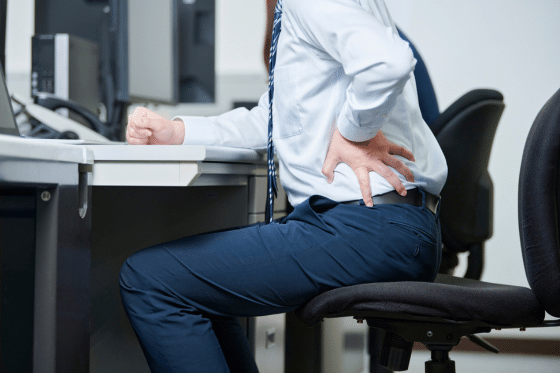TL;DR: Good posture does more than reduce back discomfort — it influences breathing, digestion, balance, mood, and joint health. Small daily changes, targeted exercises and simple workplace or home adjustments can reduce pain, lower fall risk and improve daily function for older adults. If pain or functional loss persists, consult a clinician for personalised care.
Why posture matters
Posture is the alignment of your head, spine and limbs when you sit, stand and move. For older adults, posture often changes over time because of muscle weakness, joint stiffness and habitual positions.
Poor posture contributes to back discomfort, but its effects reach wider systems in the body. Understanding those effects helps you prioritise posture as part of healthy ageing.
How posture affects breathing
The shape of your spine and the position of your ribcage influence how well your lungs expand. Slumped or rounded shoulders reduce chest expansion and can make breathing feel more shallow, especially during activity.
Improving upright alignment opens the chest and diaphragm, which often makes breathing easier and reduces the effort needed for everyday tasks. This is particularly helpful for older adults with limited reserve.
How posture affects digestion and swallowing
Compression of the abdomen from forward-slumping can slow gastric emptying and make reflux or indigestion feel worse after meals. Standing or sitting more upright during and after eating may ease these symptoms.
For older adults who have difficulty swallowing, head and neck position play a major role. A clinician can suggest safe head and trunk alignments for safer swallowing during meals.
Balance, falls and mobility
Posture directly affects your centre of gravity. Forward head and rounded shoulders shift your weight forward, which can make balance reactions slower and increase fall risk.
Because falls are a leading cause of injury in older adults, improving standing and stepping balance — by addressing posture — is a practical way to reduce risk and maintain independence.
Mood, energy and cognition
Body posture influences how we feel. Research and clinical guidance suggest that upright posture is associated with better mood, higher energy and improved self-confidence compared with slumped positions.
For an older adult, small changes in posture can contribute to better engagement in social activities and daily tasks, supporting overall wellbeing.
Joint load, pain and gradual wear
When alignment is poor, some joints and tissues take more load than intended. Over time this uneven load contributes to joint pain, accelerated cartilage wear and muscle fatigue.
Correcting standing and walking alignment redistributes forces through joints more evenly. That can reduce persistent neck and back discomfort and slow progression of wear-related problems.
Common age-related posture changes
- Increased thoracic kyphosis (rounded upper back).
- Forward head position and neck strain.
- Pelvic tilt changes affecting lower back comfort.
- Reduced spine mobility and shorter chest expansion.
These changes are often gradual and influenced by osteoporosis, muscle weakness, prior injuries and long-term habits like prolonged sitting.
Practical assessment you can try at home
Try a quick posture check: stand with your back against a wall so your heels, buttocks, shoulders and head touch the wall. There should be a small space at the lower back. If the head or shoulders sit well forward from the wall, practice gentle realignment.
If standing against a wall is painful, test seated posture: sit with both feet flat, weight balanced and shoulders relaxed. Notice whether your head juts forward or your lower back rounds.
Daily habits that improve posture
- Sit with feet flat and hips slightly higher than knees where possible.
- Use a chair with lumbar support or a small rolled towel at the lower back.
- Aim to stand and move briefly every 20–40 minutes during long sitting periods.
- Hold devices at eye level to avoid forward head posture.
- Choose footwear that provides stable support and avoids high heels.
Simple exercises for older adults
Below are safe, low-load exercises that focus on strength, flexibility and balance. Start slowly and stop if you feel sharp pain. If you have a diagnosed condition, check with your clinician before starting.
1. Shoulder blade squeezes
Sit or stand tall. Gently squeeze your shoulder blades together and hold for 5–8 seconds. Repeat 8–12 times. This strengthens the muscles that support upright posture.
2. Chin tucks
Sit tall and gently draw your chin straight back (not down). Hold 3–5 seconds and repeat 8–10 times. This reduces forward head posture and eases neck strain.
3. Wall slides
Stand with your back to a wall, arms at sides. Slide your arms up the wall into a “goal post” position while keeping contact with the wall. Repeat 8–12 times to improve shoulder mobility.
4. Seated march for balance
Sit tall and lift one knee a few inches, then lower. Alternate for 20–40 steps. Progress to standing marches holding a chair for support.
When to get professional help
See a physiotherapist or primary care clinician if you experience persistent back discomfort, new weakness, numbness, problems with walking, frequent falls or difficulty breathing or swallowing.
A clinician can assess posture in the context of your overall health, prescribe targeted exercises, recommend mobility aids and advise on bone health and fall prevention.
Assistive devices and environment changes
Small changes around the home can reinforce good posture.
- Use chairs with armrests and proper seat height to make standing easier.
- Adjust monitor height so the top third of the screen is at eye level.
- Install grab bars in bathrooms and ensure walkways are well lit.
Tips for creating a long-term habit
- Link posture checks to regular daily events (e.g., after every bathroom break or before meals).
- Use gentle reminders — a note on your desk or a phone alarm — rather than forcing uncomfortable positions.
- Mix strengthening, flexibility and balance work to support sustainable change.
What to expect from treatment
Improvements in posture and reductions in back discomfort usually occur gradually. Expect small gains in comfort, breathing and balance within weeks if you practise regularly.
Complex or long-standing problems might require a supervised rehabilitation program including manual therapy, tailored exercises and, occasionally, referral to a specialist.
Conclusion
Posture affects far more than the spine. For older adults, improving posture can ease back discomfort, support breathing, improve digestion, reduce fall risk and enhance mood and daily function. Regular, safe exercises, small environmental changes and professional guidance when needed are practical, effective steps to better posture and healthier ageing.
Click here to book your free discovery visit with us! – Free Discovery Visit – Paul Gough Physio Rooms


